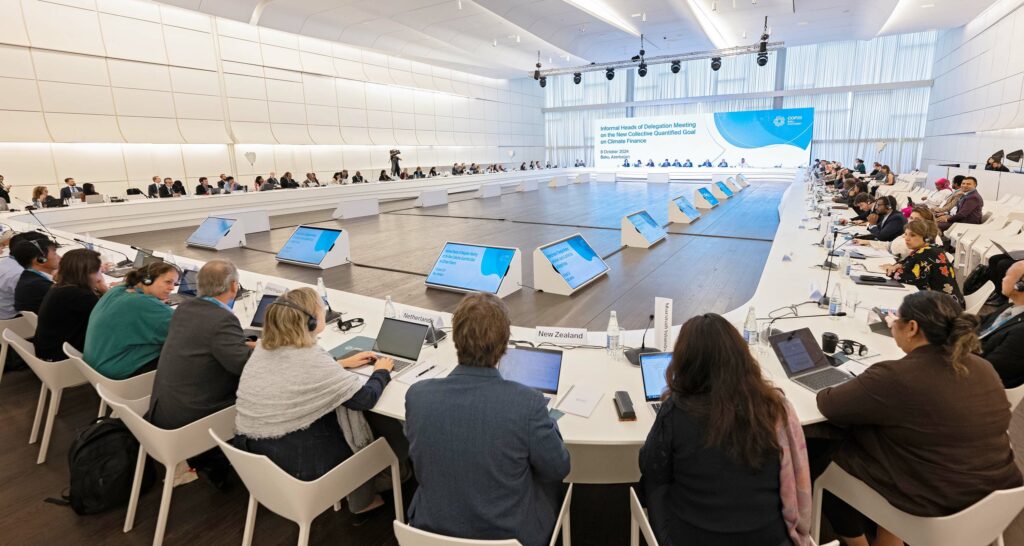Three priorities for scaling private climate finance
Calls for the private sector to plug gaps in climate investment, expertise, and entrepreneurship often overlook a critical fact: only government policy can unleash capital at scale. With targeted incentives, governments hold the power to drive the private funding needed to meet climate goals
Climate — Global

With its focus on bridging the gap between current financial flows and the investments needed to achieve global climate goals, this November’s COP29 in Azerbaijan is being described as the “finance COP.”
The Climate Policy Initiative’s Global Landscape of Climate Finance 2023 sets out the needs in very clear terms. The report suggests that current annual climate finance flows, despite doubling to almost USD 1.3 trillion in 2021/2022 compared with 2019/2020, remain far short of the USD 8 to 10 trillion needed annually over the next 30 years. It also suggests that less than 3% of the global total reached the least developed countries, and that the level of adaptation finance is less than a third of what is expected to be needed.
While private finance now accounts for approximately half the total annual climate flows, the reality is that this needs to be scaled up, given the constraints on many governments’ balance sheets. From Climate Policy Initiative’s analysis, there are three critical questions:
- How to increase the flow (or scale) of private climate finance?
- How to increase the flow of private finance to emerging and developing economies?
- How to increase the scale of private finance investment in adaptation?
Increasing flow (or scale)
The past decade has seen governments worldwide beginning to implement policies and incentives to catalyze private climate finance. Examples include the US Inflation Reduction Act, the European Union’s Fit for 55 and RePowerEU plans, Japan’s Green Transformation policy, and China’s 1+N policy framework. These policy interventions have common features that have underpinned their success:
- They are based on a “whole of government” approach, where policymakers think about how to make climate policy an integral part of long-term economic development.
- They are founded on clear commitments to climate action, providing investors with clarity and confidence about the direction of travel.
- They contain clear short, medium, and long-term targets, underpinned by comprehensive, enforceable legal mechanisms for delivery.
- They are comprehensive and at scale, covering all major areas of the economy, and all major carbon-intensive sectors. They also aim to ensure that policies support and reinforce, rather than conflict with, each other. An example of the latter are fossil fuel subsidies, which weaken the case for low-carbon investments.
- They are supported by sector-specific policies, with a particular focus on ensuring that “green” investments are financially attractive.
- They provide the right incentives to create changes in the real economy and to encourage investors to provide the capital needed to enable these changes.
Incentives need to be set at a level to ensure that climate-related investments are attractive relative to conventional investments and relative to the returns that may be achieved from other sectors. Governments may need to accept that they must provide additional incentives to overcome investor concerns about policy uncertainty and policy longevity.
Increasing flow to emerging markets
In relation to emerging markets, policymakers – domestically and internationally – need to recognize that these markets face specific challenges. These include difficult economic conditions (such as high levels of public sector debt) and practical difficulties in attracting investment capital (for example, thin domestic capital markets, and investor perceptions of risk).
The consequence is that private investors decide not to invest in these markets. Or, if they do invest, they look for higher returns to compensate for these risks. This point is well illustrated by the International Energy Agency’s 2024 report Reducing the Cost of Capital: Strategies to unlock clean energy investment in emerging and developing economies. This suggested that the cost of capital for utility-scale solar photovoltaic projects in developing countries can be more than twice as high as in developed countries.
Collaboration between governments, international organizations, and development finance institutions (DFIs) could help increase investor confidence and encourage capital inflow. For example, they could encourage host governments to:
- address corruption
- strengthen the rule of law
- ensure that contracts are enforceable and enforced
- support better management of the economy as a whole
They could also help de-risk private investments through measures such as helping manage particular risks (such as providing first loss insurance), wider economic development, building partnerships between the public and private sector, and through political and reputational credibility to projects.
Increasing scale in adaptation
Finally, in relation to adaptation, the most important starting point is recognizing that adaptation finance is quite different to mitigation finance. Some adaptation projects may be attractive to private finance if they operate on a shorter time scale and offer proven cash-flow potential (examples could include upgrading water and sanitation infrastructure).
However, the reality is that most adaptation measures are not that attractive to private investment. While there are often clear economic or societal reasons to support such investments, it is often the case that relatively few of the benefits from adaptation finance accrue directly to the entity providing the investment. Even if there are private benefits, these are often long term.
The consequence is that governments need to consider what aspects they can make attractive to private finance and which aspects need to be wholly or partly underwritten by government. For example, flood defenses could be funded through general taxation, through charges on households or through levies on insurance. All of these options raise difficult questions about the distribution of costs (and the willingness and ability to pay these costs) and the distribution of benefits. However, it is important to be aware that in the absence of the right incentives, private finance will not step up at the scale or within the timeframes needed.
Conclusion
In conclusion, none of the solutions to increasing private climate finance or to increasing private finance flows to emerging markets or into adaptation is politically easy or inexpensive. Ultimately, however, to deliver on the world’s ambitious and urgent climate goals, domestic and international governments need to establish feasible implementation plans, clear policy frameworks, and provide clear incentives for private sector participation.
Can it be done? The answer is yes, if governments have the right level of ambition and, critically, a willingness to properly analyze and assess the risks that need to be managed.





